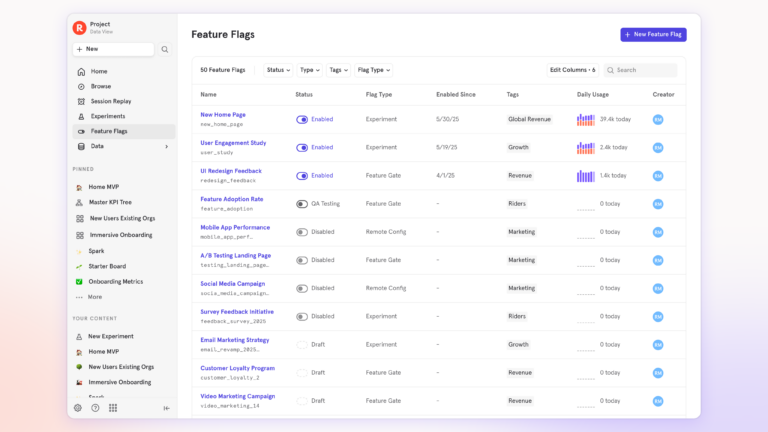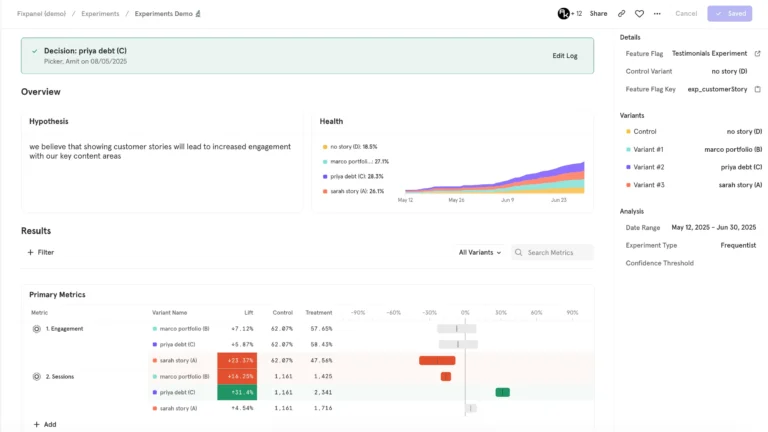What is feature management? A complete guide to data-driven feature control.
As any good product team knows, shipping a new feature isn’t the finish line. It’s just the starting point for learning. A solid feature management process is crucial for turning lessons into action because it lets product teams safely roll out, test, and optimize features in production.
Keep reading to learn about what feature management is, strategies, best practices, and why analytics are the key to accessing a continuous innovation loop throughout your feature management process.
Feature management explained
Feature management is the practice of controlling the release and behavior of software features, usually to test certain features for different user segments. For example, a product team might release a new onboarding flow to just 10% of new users to evaluate its impact on activation rates before rolling it out to everyone.
At its core, feature management helps teams reduce risk while validating ideas and hypotheses quicker. Instead of rolling the dice with a full release, you can safely test a new feature with a small cohort, measure impact, and iterate before opening it up to your entire user base.
We’ll dig into the core components of feature management shortly, but for now, here’s a quick summary of the major parts of the practice:
- Feature flags or feature toggles: These are conditional logic switches that allow teams to enable or disable features at runtime, without requiring a new deployment. They provide critical control over when and how features are released, making it easy to test in production, manage phased rollouts, or instantly disable problematic updates.
- User targeting and segmentation: Feature management tools often include the ability to target specific user groups based on criteria like geography, subscription tier, device type, or behavioral cohorts. This allows teams to tailor the experience, test variations with different segments, or gradually roll out features to minimize risk.
- Experimentation frameworks: Different teams will use different frameworks based on what they’re prioritizing, like speed or statistical rigor. Know the steps of the framework you’re using. (Learn more about product experimentation and frameworks.)
- Configuration management: Beyond just toggling features on and off, many systems support dynamic configuration, which allows teams to move more quickly by adjusting feature behavior (like thresholds, copy, or UI) without having to deploy code.
Why feature management matters for product teams
When implemented well, feature management turns every release into a learning moment and empowers teams to make smarter decisions, faster. The result: tangible business benefits across multiple departments, including Product, Engineering, and Demand Gen. Here are a few of the biggest benefits:
1. Faster time to market with reduced deployment risk
Feature management decouples deployment from release. Using feature flags, engineers can ship code safely, while product managers control when and how it goes live—enabling gradual rollouts, instant rollbacks, and dark launches with minimal risk.
Golfshot, a leading on-course GPS, scoring, statistics, and auto shot tracking app, has a unique approach to feature management as part of its launch process. The goal: to ensure healthy adoption rates from day one.
“What we do a lot of the time is quiet releases of new features to see how discoverable they are,” says Kyle Schomer, Senior Product Manager. “We’ll update the app and monitor the stability, and see how many people are finding the feature organically. If they’re not, then we start putting in breadcrumbs or announcements that lead them to the new feature.”
2. Ability to respond quickly to user feedback
Rolling out features to small cohorts also increases agility and allows product teams to collect feedback, monitor engagement, and make real-time adjustments more quickly without requiring a full release. This shortened feedback loop both reduces risk and maximizes the impact of each iteration by enabling more data-driven decisions and faster innovation cycles.
3. Improved team alignment and operational efficiency
A good feature management strategy also improves cross-team collaboration. Not only does it make engineering releases less risky, it also empowers PMs to own the launch strategy and makes it easier for data teams to measure performance. More importantly, this all happens within a shared framework, which increases visibility and accountability.
For example, Bolt, a Europe-based app, offers more than six primary services (including ride hailing and food delivery) across over 500 cities in Europe and Africa. With many services and such a scattered user base, the team needs a high level of data and analytics visibility across regions and functions to ensure a consistent user experience as it launches new features.
As part of its feature management strategy, Bolt gave its Engineering, Product, and Data teams access to shared analytics. That led them to realize that a small number of users on outdated Android versions were generating limited business value. This allowed the teams to align around a data-backed decision to sunset support for Android 4 in favor of a simplified version—freeing up around 15% of the Android engineering team’s capacity and enabling them to focus on higher-impact initiatives.
4. Better resource allocation through performance insights
Another reason feature management matters to product teams is that it reveals what’s working (and what’s not). This reduces time wasted on scaling features that don’t move the needle, while focusing efforts where there’s proven ROI.
💡 See how Brightside, an all-digital mobile-first banking app, used analytics-backed feature management to pinpoint friction and optimize its account open flow to increase conversion rates for new account opens to 85%—an increase of 30% in less than six months.
Core components of effective feature management
No matter how your team manages feature management, there are some core components to keep in mind. Here’s a deeper look at the essential building blocks of the practice.
Feature flags and targeting
Feature flags are the foundation of feature management. These conditional logic gates allow teams to enable or disable features dynamically without changing the underlying codebase or redeploying.
You can also layer targeting on top of feature flags for more strategic control. Instead of flipping features on or off globally, you can release them to specific cohorts like power users, internal Quality Assurance (QA) teams, or users in a certain plan tier.
For example, you might set up a feature flag with the logic “If the user is an existing customer, show them welcome screen 1B in the mobile app.”

💡Pro tip: See the 6 most common feature flag mistakes and how to avoid them.
Experimentation and A/B testing
Experimentation (often through A/B testing) is the engine that helps product teams improve continuously.
Effective experimentation requires rigorous design. That starts with ensuring statistical validity—defining hypotheses, establishing appropriate sample sizes, and running tests long enough to reach significance. Without this discipline, you risk making decisions based on noisy or misleading data.
This is where the OADA loop (Observe, Analyze, Decide, Act) offers teams a structured way to iterate and learn: You observe user behavior, analyze data to form a hypothesis, decide which tests to prioritize, and act by rolling out experiments. Experimentation shouldn’t happen in isolation, and this cycle helps teams think of testing as a continuous process.
And when experimentation tools are integrated with your analytics platform, the learnings become even richer because you can tie the performance of each variant more confidently to funnel performance, retention, and other metrics.
Analytics and measurement
A robust analytics platform makes it possible to immediately see how new (or potential) features impact engagement, conversion, retention, and more across different segments or user cohorts.
For example, by tying feature flags directly into your analytics engine, you gain access to:
- User behavior analysis during rollouts. See how different users interact with a feature over time.
- Conversion funnel insights. Understand if a feature improves the steps that matter most.
- Business impact tracking. Measure whether a feature meaningfully contributes to growth or retention, and by how much.
When analytics is at the heart of your feature management strategy, you’re not just shipping features—you’re making data-informed, low-risk bets that can be measured, iterated, and scaled up.
Common feature management challenges and solutions
While feature management offers significant benefits (like safer rollouts and faster feedback loops), it also introduces new complexities. Without the right processes and tools, teams can quickly find themselves struggling with technical debt, cross-functional misalignment, or an inability to properly measure success.
Let’s break down three areas where teams often struggle, and some actionable strategies to overcome these challenges.
1. Technical debt and flag management
As helpful as feature flags are, they become a liability when left unmanaged. Over time, flags accumulate in the codebase without clear ownership or documentation. This leads to bloated code, confusing logic paths, and hard-to-diagnose bugs—all of which slow down development and increase maintenance risk.
To mitigate this, schedule flag cleanups as part of the development cycle, like any other form of technical debt. Adopt consistent naming conventions and add metadata (such as owner and expiration date) for every new flag, and implement automated expiration policies where flags are reviewed or disabled after a defined period.
Solutions that support feature flag lifecycle management (especially if they’re integrated with or built into your analytics platform) make it far easier to determine when a flag is no longer needed.
2. Coordination across teams
Feature rollouts don’t happen in a vacuum. They often span multiple departments from Engineering and Product to QA, Marketing, and Support. Without a clear communication plan and shared visibility, even well-planned launches can descend into chaos.
To avoid these pitfalls, consider establishing:
- Explicit flag ownership. Every flag should have a designated owner responsible for its lifecycle and performance.
- Shared dashboards and documentation. All stakeholders should be able to view flag status, targeting rules, and rollout progress.
- Cross-functional release rituals. Whether through weekly meetings, Slack channels, or shared calendars, teams should sync regularly on upcoming launches and rollout plans.
These practices not only reduce errors, but also build trust between technical and non-technical teams—ensuring that everyone understands what’s being released, when, and why.
3. Data and measurement challenges
It’s relatively easy to flip a switch and enable a feature, but it’s often harder to determine whether that feature actually improved user experience or business outcomes.
From events that aren’t properly tracked to noisy feedback loops, teams can find themselves drowning in data—with no actionable insights—making analysis impossible.
One solution is to embed analytics directly into your feature rollout process. Track key events tied to feature flags to monitor adoption, engagement, and drop-off points. Know what success looks like in these areas. (Is it an increase in conversions, retention, time spent, or another metric?)
Analytics-driven feature management with Mixpanel
Most feature management platforms focus on control. While Mixpanel does give you that level of granularity, it also adds detailed context that makes it possible to understand why a feature performs well (or doesn’t).

With Mixpanel, product teams can:
- Monitor feature performance in real time, tied to conversion and engagement data. For example, Mixpanel’s Funnels calculate and display conversions from one event to another within a particular time window. This lets you identify where users are dropping off, which segments are the highest-converting, and other important facets of the user journey.
- Use cohort analysis to see how different user groups respond to new features and engage over time
- Track retention changes when new features are introduced with advanced retention reporting
- Set up alerts when metrics move unexpectedly after a feature rollout. Mixpanel also has a Root Cause Analysis feature that helps you investigate and understand the underlying data behind alerts, ultimately making it easier to identify the user segments affected and address issues quickly.
Measuring feature success: Key metrics and approaches
How do you know if a feature rollout is successful? It’s best to track these KPIs and analytics methods from day one:
Core metrics
- Adoption rate: What % of users engage with the new feature? This helps you gauge initial interest and ease of discovery.
- Conversion impact: Does it improve funnel performance? This is an important core metric because it helps you prove ROI by measuring changes in sign-ups, purchases, or other conversion events before and after launch.
- Performance metrics: Any spikes in latency, load times, or errors?
- User feedback: Are NPS or satisfaction scores improving? User feedback can be qualitative or quantitative—consider using both to get more context beyond raw usage numbers.
Other advanced analytics approaches
- Cohort analysis for long-term impact on different user segments. For example, you might compare the behavior of early adopters versus late (or not at all) to spot retention or engagement trends over time.
- Segmentation analysis to uncover differences between user groups. Understanding which personas are most responsive is vital because it informs future targeting strategies for new features. (For example, which user types should you prioritize in staged rollouts?)
- Multi-touch attribution: Not every feature is meant to make a direct-line impact. Multi-touch attribution helps you prove the value of a feature through indirect conversions.
- Predictive analytics let you model likely feature success before a full rollout by forecasting metrics like adoption and retention using historical usage and behavioral patterns.
Turn feature management into a growth engine
Feature management sits at the intersection of experimentation, analytics, and cross-functional alignment. The ability to roll out changes incrementally, measure their impact in real time, and act on those insights is a powerful competitive advantage because of the learnings it offers.
By combining granular control with deep user understanding, teams ensure that every feature they ship is intentional, impactful, and educational—transforming feature management into a repeatable, data-driven engine for growth.
With the right platform, teams can release faster, iterate more effectively, and ship features that drive real business value. Learn how Mixpanel’s robust experimentation helps teams make data-informed with a demo today.


